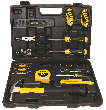Unclogging a Kitchen Sink Using a Wet/Dry Vacuum
Do you have access to a wet/dry vacuum? If you do, or if you can get to a hardware rental place that offers them, then you have the perfect tool to use for fixing the most common of all household plumbing problems: The problem of a clogged drain. The principles behind using a wet/dry vacuum are the same as if you were using a plunger, but with much more power and suction.
It is fairly easy to use a wet/dry vacuum to remove the blockage in your kitchen, just use the following step-by-step instructions, and you clogged sink will be a thing of the past.
Before starting to actually use the vacuum, you will want to make sure that you have a few old towels around. This will help in case you spill any of the water and gunk that you clear from your drain. This mess could come from either blowback or because you drop the cylinder that contains the junk that you have removed. Remember the old Scout motto of "be prepared."
- Set up your wet/dry vacuum in the kitchen. Make sure that you have set up the vacuum as directed by the instructions that came with the vacuum or as told by the rental agent. You want to make sure, whenever you use any type of power tool, that you follow all the instructions. This is for your safety, as well as ensuring that you do not damage the tool so that you can get your rental deposit back.
- Hook the hose of the vacuum into the "blow" or "exhaust" position and stick the hose into the drain, forming as tight of a seal as you can. You are going to use the positive air pressure from the vacuum in an attempt to break up the clog in the drain. You are going to initially hear a high-pitched hum or whine from the vacuum as the air pressure is generated to break up the clog. When the blockage has been broken up, you are going to hear a distinct change in the sound of the vacuum's motor.
- There may be a blowback from the air pressure, which can lead to mess, so be prepared to clean up any dirt and gunk with old towels.
- If there doesn't seem to be any change in the drain's water flow, then you are going to want to switch the air hose to the suck position. By switching the position of the hose back and forth several times, you are going to be simulating the action of a plunger, but with greater force.
- Another benefit from using the suck position is that all of the mess gets sucked up into the holding canister of the vacuum. This leads to less mess and a much easier clean up, as long as you do not spill the canister.
Author Bio
Doris Donnerman
Doris is a jack of all trades, writing on a variety of topics. Her articles have helped enlighten and entertain thousands over the years. Learn more about Doris...
Fight Fleas with Rosemary or Eucalyptus Shavings
Fleas are nasty and anything you can do to deter fleas from your pets is a good thing. Try using rosemary and eucalyptus ...
Discover More
Watch Out for Cats Hiding in Warm Places
Cats have a tendency to find and enjoy warm places for relaxation. However, you should watch out for some of these places ...
Discover More
Mastiff
Once known as the largest dog in the world, the Mastiff was a gamekeeper's dog. He is ferocious in nature and was best ...
Discover More
More Home Improvement Tips
Unclogging a Bathroom Sink Using a Plunger
Bathroom sinks seem to be susceptible to a large number of clogs or blockages. If you are interested in performing your ...
Discover More
Unclogging a Utility Sink Using a Snake
Utility sinks may clog up on you at almost anytime. The reason for this is simply due to the various abuses that they are ...
Discover More
Unclogging a Utility Sink Using Chemical Cleaners
Utility sinks are put through a whole lot of abuse, and as such they are subject to frequent clogging. Use these steps to ...
Discover More

Comments